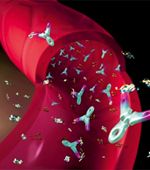Bevacizumab Shows Promise in Non-Small-Cell Lung Cancer as Maintenance Therapy
Maintenance therapy with bevacizumab following combination therapy with bevacizumab, pemetrexed, and carboplatin could be an effective treatment for patients with advanced, nonsquamous non-small-cell lung cancer (NSCLC), according to a new study.
Maintenance therapy with bevacizumab following combination therapy with bevacizumab, pemetrexed, and carboplatin could be an effective treatment for patients with advanced, nonsquamous non–small-cell lung cancer (NSCLC), according to a new study.

Illustration of bevacizumab in the bloodstream, where it encounters VEGF secreted by the tumor, and binds to it. Image source: Roche.
“Our efficacy end points all compare favorably to prior reports of front-line bevacizumab-containing regimens in nonsquamous NSCLC, and we found the regimen to be tolerable, with some patients able to receive many months of maintenance bevacizumab therapy,” said study lead author James P. Stevenson, MD, of the Abramson Cancer Center at the University of Pennsylvania in Philadelphia. The results of the phase II trial were published recently in Cancer. Approximately 75% of the 1.6 million new lung cancer cases worldwide each year are NSCLC, and most patients present with advanced disease.
Stevenson and colleagues enrolled 43 NSCLC patients to the study, with 40 eventually evaluable for response; all patients had an Eastern Cooperative Oncology Group performance status of 0 or 1. The patients had an average age of 65 years, and there were 23 men and 20 women included; most patients (82%) were white. All participants received bevacizumab, pemetrexed, and carboplatin, and the 25 patients who responded or were stable and completed six cycles, then went on to receive bevacizumab maintenance therapy every 21 days until disease progression. Of the 25 who started maintenance therapy, the average number of further bevacizumab cycles was 9, though it ranged as high as 59 cycles.
Two patients experienced a complete response, and 17 others had a partial response, yielding a response rate of 47%. Fifteen other patients (38%) had stable disease. After a median of 15.8 months of follow-up, the median progression-free survival was 7.1 months, and the median overall survival was 17.1 months. Six patients were alive at least 3 years after study entry.
The regimen was generally well tolerated, with few grade 3 and 4 toxicities reported. The most common were neutropenia and anemia during the initial six treatment cycles, and nausea and headache during the maintenance phase of the trial.
Stevenson said in an e-mail that this study adds to a growing body of evidence in support of bevacizumab maintenance therapy in NSCLC, “particularly in patients who have the nonsquamous histologic subtype, as these patients are potentially eligible to receive bevacizumab and pemetrexed-containing therapies.”
Other studies have found similar efficacy with a maintenance regimen of bevacizumab plus pemetrexed after the same initial combination treatment. “The question of doublet vs single-agent maintenance therapy is therefore of great interest as doublet therapy would be expected to be more toxic and costly,” Stevenson said. “This question is now being studied in several randomized trials [and] the overall survival results from these trials are expected soon.”